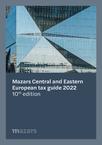
Mazars Central and Eastern European tax guide 2022
Mazars Central and Eastern European tax guide 2022
The guide offers up-to-date information on taxation in 22 European countries, including labor costs, corporate profit taxation, and transfer pricing. The guide serves long-term investment decisions by analyzing long-term taxation trends and fundamental changes in the tax regimes, both in comparison with each other and to previous years.
The guide analyses the tax regimes of the South-Eastern European countries, Germany, Austria, Moldova, Ukraine, and the Baltic States, focusing on changes and trends in the tax regimes.
Key findings:
- The region's tax wedge remains relatively wide, ranging between 15 and 51%.
- Countries maintain a characteristically different approach to income taxation and tax relief for families with children.
- VAT remains the prime source of tax revenues in the listed countries; digital technologies have visibly improved the efficiency of tax collection.
- There are still significant differences in the approach to corporate taxation in the region. Only one country reduced its corporate profit tax rate from last year.
You can also visit the interactive online platform on Mazars the CEE tax guide 2022
Contact


